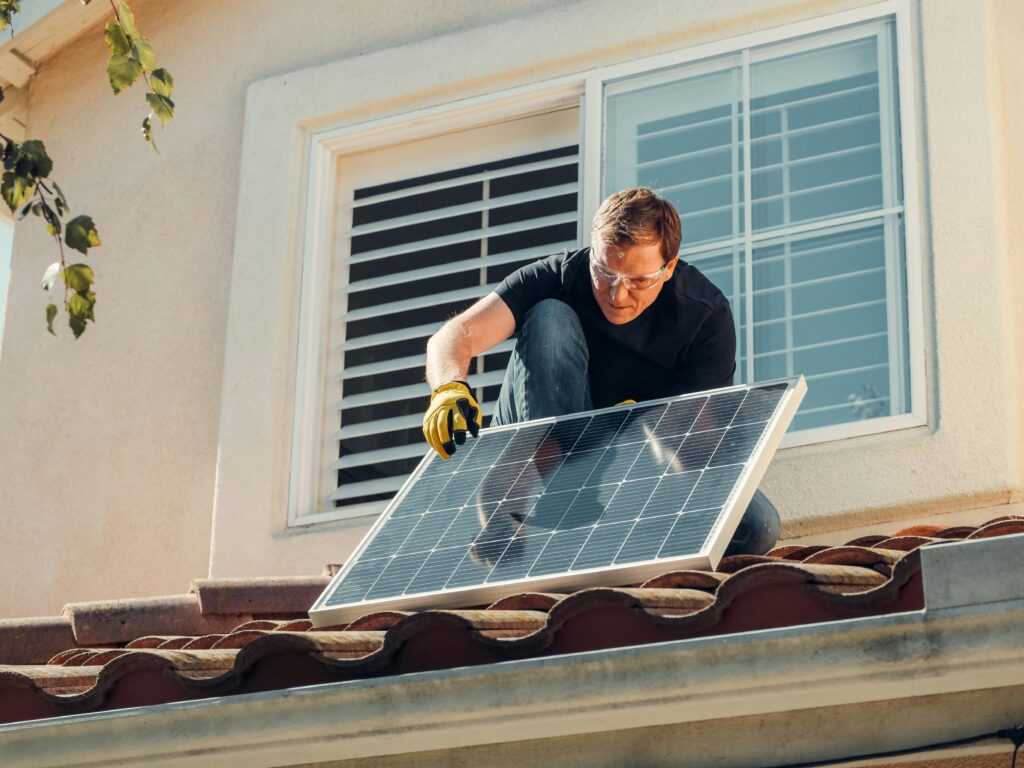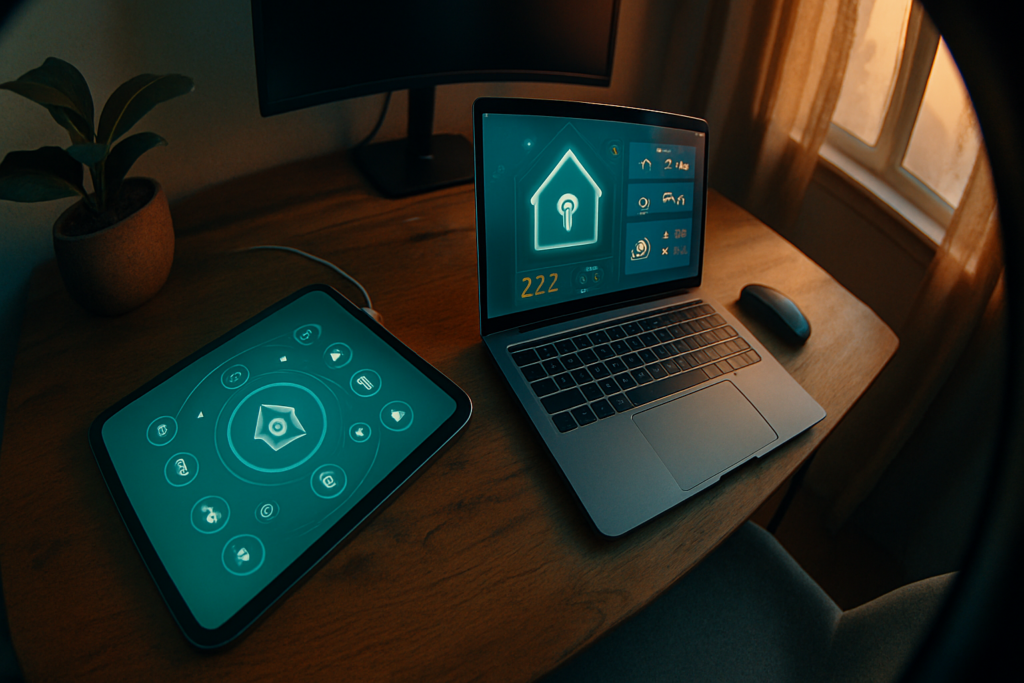Source: Man with Gloves Holding Solar Panels on the Roof · Free Stock Photo
Can you imagine a home that generates as much energy as it consumes? One that powers all your devices, efficiently heats and cools itself, and even sends unused electricity back to the grid?
These are called net-zero homes. They sound like something out of a sci-fi movie, but they’re a real thing. And getting your home to be net-zero might be easier than you think.
In this article, we’ll go through cutting-edge smart technologies behind net-zero homes, helping the environment (and even resulting in a “net-zero” electricity bill in the process!).
Solar Power: The Heart of the System
Solar panels are perhaps the most important component of a net-zero home.
These photovoltaic (PV) panels convert sunlight into electricity, providing a renewable, theoretically infinite source of energy at least until the sun explodes in 7 billion years.
Depending on the size, location, and design of the house, as well as the size of its solar panel system, they can easily meet—or even exceed—all of a home’s energy needs.
While the upfront installation costs are definitely expensive, people can save up hundreds of dollars on their monthly electricity bill, leading to long-term financial benefits.
However, solar production alone isn’t enough. The levels of both sunshine and energy use fluctuate a lot. Here’s where smart technology takes over.
Smart Inverters and Energy Monitoring
Smart inverters don’t just convert DC (direct current) electricity from solar panels into AC (alternating current) electricity for your home. They actually act as the brains of the system.
These devices are responsible for monitoring production and optimizing the performance of the other devices in your system. They can even return excess energy to battery storage or the grid.
When paired with energy monitoring systems, smart inverters allow even non-tech-savvy homeowners to track energy use in real time through simple phone apps.
For example, they can provide detailed information about which appliances are consuming the most energy. With this, users can make smarter choices about their energy use.
Energy Storage: Battery Technology
Speaking of batteries—yes, in case you didn’t know, homes can now have batteries. Products like Tesla’s Powerwall or LG’s RESU store excess solar energy generated during the day. This stored backup energy can then be used during times when sunlight is scarce.
This allows homes to be energy-independent, which means that they’ll have power even if the electricity grid is down (and their neighbors are scrambling during a blackout).
These batteries are also smart batteries. They learn usage patterns and adjust charging and discharging cycles automatically. It’s a set-it-and-forget-it kind of affair.
Smart HVAC and Climate Control
Heating and cooling typically account for the biggest energy expenses. Net-zero homes address this with highly efficient HVAC systems, controlled by smart thermostats like Nest or Ecobee.
These devices automatically learn your habits—whether you’re at home, asleep, or away—and adjust temperatures accordingly. Incredibly convenient, no?
More advanced systems even take it a step further by integrating with weather forecasts and occupancy sensors to precondition your household more efficiently.
Many net-zero homes also have heat recovery ventilators (HRVs) or energy recovery ventilators (ERVs). These systems use the heat from exhausted air to pre-warm fresh incoming air, improving energy efficiency without compromising air quality indoors.
Smart Lighting and Appliances
LED lighting is up to 80% more energy efficient than traditional fluorescent or incandescent bulbs. This makes it a staple in net-zero homes.
And when paired with automation systems like Philips Hue or Lutron Caséta, they can become even more efficient through scheduled dimming, remote control, and automatic, occupancy-based adjustments.
Smart versions of various household appliances are now widely available, too. Energy Star-rated dishwashers, washers, dryers, and refrigerators now come with features that make them more efficient. For instance, a smart dishwasher may delay its cycle until the connected solar panels are receiving peak sunlight.
Intelligent Water Heating
Water heaters are also a significant energy drain. A smart alternative used by net-zero homes includes heat pump water heaters. Like the aforementioned HRVs and ERVs, these draw warmth from the air to heat water, using far less electricity in the process.
These systems can come with smart controls, allowing them to operate during off-peak hours or when solar energy is abundant.
Building Envelope and Insulation
While not a “tech” in the traditional mechanical or digital sense, a net-zero home’s “building envelope”—including insulation, windows, and air sealing—also contributes to achieving net-zero.
By using advanced materials and construction methods, one can ensure minimal heat transfer and air leakage. This also reduces the load on HVAC systems.
Some houses even have dynamic insulation systems that respond to environmental conditions and adjust thermal resistance accordingly in real time.
Grid Interaction and Net Metering
And did you know that you can even sell the excess power your solar panels and other systems generate? This can be done through energy providers’ net metering programs. Smart meters track the two-way energy flow from individual houses to the grid, which ensures fair and accurate compensation for homeowners.
Some areas even have demand response programs. Here, utilities can pay homeowners to reduce or shift their energy use during peak periods. Homeowners can then become active participants in the broader energy ecosystem (and not just passive consumers).
Common Concerns About Net-Zero Homes
- Upfront Costs
Building a net-zero home costs significantly more than traditionally powered houses.
- Digital Security
With all these systems needing an internet connection, sensitive household information is at risk. These systems often need to be used with virtual private networks (VPNs). Don’t know what a VPN is? Click here for a VPN for dummies guide.
- Local building codes and zoning laws
Local infrastructure and regulations may limit or affect your ability to sell your excess power or install solar panels, energy storage, and other necessary components.
A Smarter Future
While they aren’t the norm yet, more and more people are aiming for a net-zero home. After all, it helps the environment, empowers the homeowners, and is great for long-term finances.
While not widely accessible yet, the cost of solar panels, batteries, and smart systems continues to fall. Governments also incentivize green projects. And last but not least, people are simply becoming more aware of climate change and seeking more control over how they use energy.
So, are net-zero homes the future? Well, there’s little to no reason why they at least shouldn’t be.




